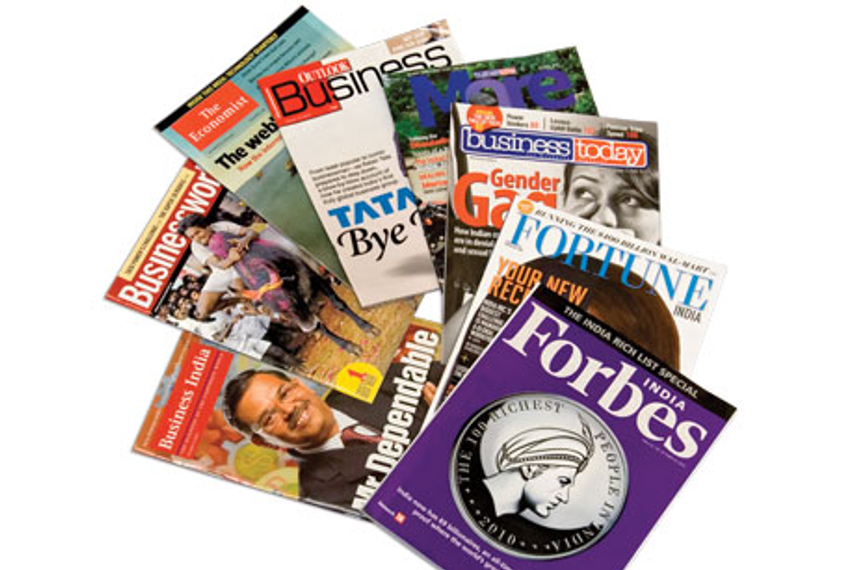
There are people who prefer their news ticker-style on a television channel, but the business magazine still has its fans, judging by the sheer number that are now available on newsstands. Here’s what we could find out about the genre in India, and where it’s headed:
1 When Business India launched in 1978, there was no real market for business magazines, according to Pheroza Bilimoria, managing director, Business India Publications. "There was just a trade magazine called Commerce Weekly, and even the financial dailies were very staccato and matter of fact in their style of reporting," she recalled. "Even businesses would operate in a shroud of secrecy. Business India opened up avenues for companies to understand their responsibilities to the general public." The challenge extended to getting advertisers on board as well. "The concept of business magazines didn’t exist and people wondered how long it would be before we ran out of material," she said. Bilimoria admitted she would go crazy trying to fill pages, and most of the ads the magazine did get were out of goodwill from acquaintances.
Things did improve through the course of the year, and thereafter. “No one had heard of mergers and demergers, and a few of the big stories we reported were the DCM and Mafatlal split. We talked about things like the free floating of the rupee and nuclear power, much before actual developments took place,” explained Bilimoria. The response from readers and advertisers became warmer as well. “The reception from the business community was enormous, circulation improved via word-of-mouth and eventually, our appointment ad pages ran into 30 pages every fortnight and there would be a backlog ready for the next issue,” she said.
2 Next in the fray was Businessworld, a publication of ABP, in 1981. The 1990s saw the opening up of the economy and consequently new offerings in television and print media. The India Today Group launched Business Today in 1992, and the Outlook Group brought out Intelligent Investor (now Outlook Money) in 1998. In April 2006, Outlook Business came to newsstands. 2007 saw The Economist open its commercial office in Mumbai to support the editorial office in New Delhi. In 2009, Forbes Media LLC and Network18 began to publish an Indian edition of Forbes. In October 2010, Fortune landed on Indian terrain.
3 The Indian business magazine reader has, of course, evolved through the course of these developments.Ajay Chacko, chief executive officer of Forbes India, said, "The reader here was looking for ‘perspective’ from a business magazine, not news or analysis that skimmed the surface. Most of our readers are exposed to multiple media so there was no point competing with the internet or TV or dailies when it comes to news breaks or quick edits/ analyses." The magazine had to find a niche for itself. "Issues may be personality-led, business-led, policy-led, global or local, but readers today look for that ‘distilled understanding’ to help get an informed grip," he said.Pavan Varshnei, president, Fortune India added, “There is always a market for a good product. Business brands that provide content that is relevant, insightful and credible in an engaging manner will be preferred and will find a dedicated readership / audience.”
4 The keyword for the future, as with other publications across genres, is "relevance". "The key challenge for the business magazine (or for that matter any magazine) is to remain relevant to the reader, be of value and continue to be differentiated. There is a media ‘overdose’ in India (like in many markets) and to stay relevant is going to be the primary challenge," said Chacko. He also felt that the second major challenge is on the distribution front. "I think magazine distribution in India hasn’t really kept pace with the changing lifestyles of people - though someof us are trying to innovate using newer methods of distribution. When was the last time youvisited a newsstand?" he asked.
Bilimoria added, “The market has become more competitive and fragmented but each major publication has identified its own positioning. The way togo in the future would be acombination of print, electronic and digital.”
What it means for…
Advertisers
- Plenty of avenues to advertise in print or the web
- Better segmentation of readers as each magazine finds its own positioningthe reader
The Reader
- Different styles of analyses and coverage to peruse
- New ways to get their news in the future, as magazines hone their digital strategies


.jpg&h=334&w=500&q=100&v=20250320&c=1)
.jpg&h=334&w=500&q=100&v=20250320&c=1)



.jpg&h=334&w=500&q=100&v=20250320&c=1)


.jpg&h=334&w=500&q=100&v=20250320&c=1)
.jpg&h=334&w=500&q=100&v=20250320&c=1)



.jpg&h=268&w=401&q=100&v=20250320&c=1)




